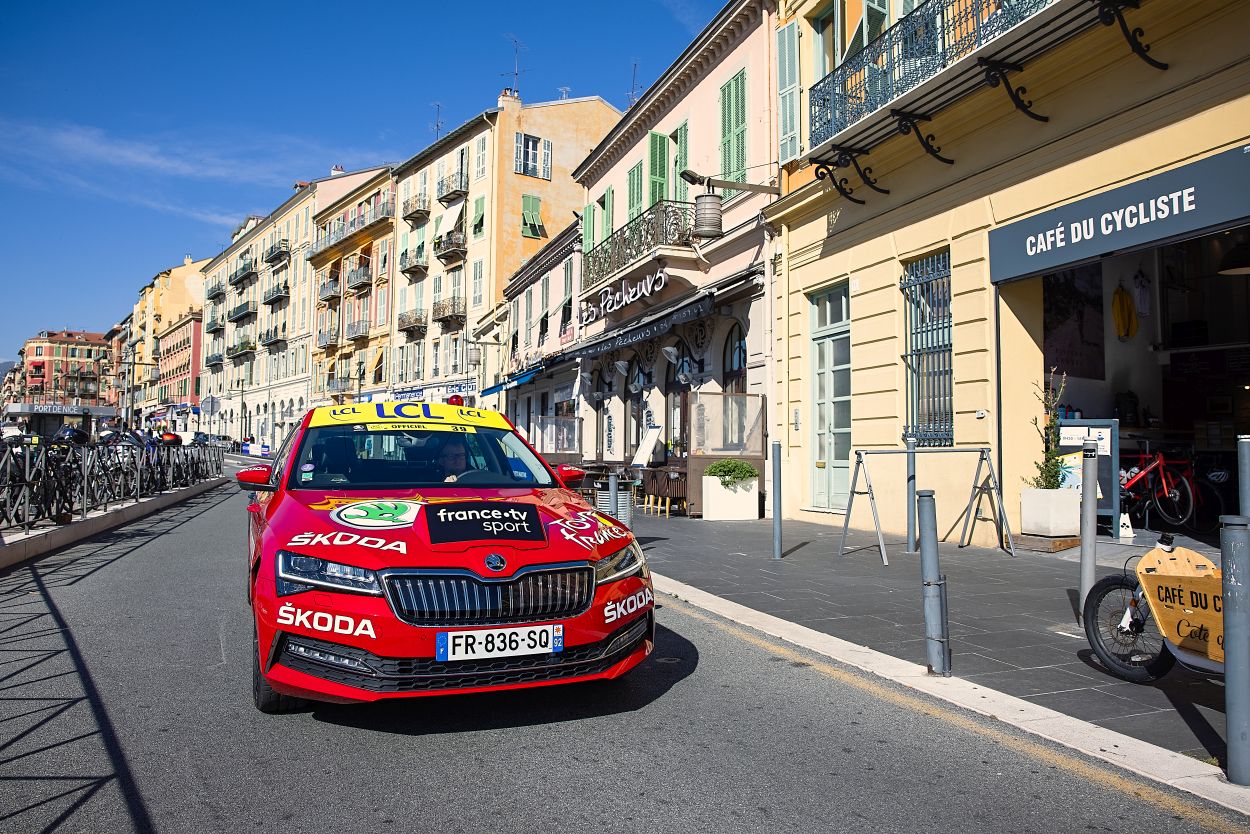The Amaury Sport Organisation, responsible for organizing the three-week race, had kindly offered to lend me the car for a test drive. What a responsibility, I’m pondering. Even more so as the Grand Depart is only three days away. Trying not to think what might happen if something were to go wrong with this significant SUPERB iV, I take a deep breath and take my chances. Holding the keys in my lightly shaky hand, I open the door.

This is my very first experience with the Škoda SUPERB iV whatsoever. After the fully-electric Škoda CITIGOe iV, this plug-in hybrid version of Škoda’s flagship model is another milestone of Škoda making its mark in the era of electromobility. Introduced just a few weeks before last Christmas, it must have piqued the interest of any Škoda fan who believes in progress coming hand in hand with a responsible approach to the environment.
It is no surprise that this very car was specially modified to work as the mobile command centre from which the Tour’s director will manage the 107th edition of the race. The car is easy to distinguish not only by the noticeable ‘VELVET RED’ paint finish but also by the numerous logos of the Tour and its official partner Škoda all over the bodywork. There is also the distinct plastic label on the bonnet, bearing the names of all the French TV channels, which will broadcast the race. In comparison with the previous Director’s cars, no radical evolution has been made from the outside. The plug hidden behind the grille together with a silver iV label above the rear bumper are the only eye-striking distinctions.
I get inside the car, shut the door, fasten the seatbelt and push the ignition button to set off. Just in time for the traffic of the seventh most populated city in France to go wild. The entire city immersed itself in a Tour fever and driving through its streets makes me think that I am descending into an ever-present madness.
As soon as the Tour bursts out, Christian Prudhomme will likely settle himself into the back seat of this very SUPERB iV and, by waving a white flag from the roof window, he will start the stage every day. A random pedestrian knocks on my window and asks me what for is the forest of antennas on the roof. I try to explain to him that Mr Prudhomme needs to stay in permanent touch with any possible structures of the organisation.
That’s why the car features an impressive range of technical equipment. Including six radio antennas on the roof, several microphones, and four radio channels installed on the two consoles placed beneath the dashboard in the front on the passenger’s side and in between the front seats. This is the place from where Mr Director transmits and receives orders and information, organises traffic around the peloton, and stays in constant contact with the race marshals and the entire Tour car fleet. While Prudhomme sits behind the driver, the right-side rear seat is reserved for honoured guests to whom a chilled Champagne will be served from the renowned auto-minibar.
Anytime I stop at the crosswalk, a crowd immediately starts taking pictures, which is no wonder as the car is simply very eye-catching. On several occasions, I cannot help myself but greet them back with the signature honking tune of the Tour, launched by pressing the middle of my steering wheel like a common horn.

The best among the first impressions is how familiarly the car behaves. The director’s limousine feels even more comfortable and cultivated than what I remember from driving the latest Škoda SUPERBs without the new plug-in technology.
Somewhere deep under the bonnet, however, high-voltage magic takes place. The plug-in hybrid propulsion mixes up a conventional supercharged 1,4 TSI engine delivering the output of 156 horses with an electric engine, which is hiding some extra 115 horses. With the assistance of a six-gear direct-shift gearbox, the power is distributed to the front wheels. The recharging process either takes five hours when done by the electric power network or shrinks to mere 3,5 hours when charged through the original Škoda Wallbox.
When completely recharged, the car can easily roam for 60 kilometres without burning a single drop of petrol, regardless of how much I will step on ‘the gas’ pedal. The range might not cover the distance of the Tour de France stages, yet it is fair enough for my today’s ride around Nice, which is what most of us need for commuting anyway. With the combustion engine backup dwelling under the hood, I can stay calm even if the battery runs out of juice. Then the car would simply switch from electricity to petrol and take me home the more traditional way.

Most of the time, I’m enjoying the best feature of hybrid technology, which is the ability to combine both available sources of power. This way, I can reach an average consumption of 3 litres per 100 km without losing the joy of a dynamic ride. While cruising through the Tour routes, I’m almost subconsciously observing differently-coloured charts, jumping on the screen, that inform me about the kind of power source currently used.
Škoda SUPERB iV is absolutely noiseless unless the combustion engine takes over. This is why the e-noise generator is built into the front to alert inattentive pedestrians or cyclists long before the car gets too close. I’m glad to have that device on board in a city full of people stepping into my lane unexpectedly, and bikes filling any possible gap between the cars in the afternoon congestion.
Slowly and step by step, I’m making my way back to the Acropolis. When pulling over to get in the palace, police are closing the roads to clear them for the event. The Tour is inevitably approaching. I believe that this year, I will not miss a single stage. Just to watch the car I could put my hands on.









